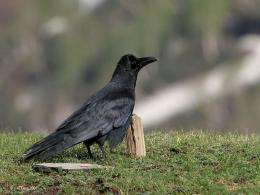October 10, 2011 report
Crows are capable of distinguishing symbols, study finds

(PhysOrg.com) -- A new study published in Animal Behavior shows that crows are capable of recognizing symbols designed to represent different quantities and is one of many different studies currently looking at the behavior and intelligence of crows.
The new study, conducted by a team of Japanese scientists led by Shoei Sugita from Utsunomiya University, looked at eight jungle crows. These birds are a larger, bigger-beaked relative to the American crow. The idea behind the first experiment was to determine if crows were able to determine which container held hidden food based on a symbol on the lid of the container.
The birds were presented with two opaque containers, one with food and one without. The symbols used were the number “two” and the number “five.” The container with the number five on the lid was the one holding the food. When the birds were presented with the containers they had a 70 percent success rate in choosing the container with food.
Other experiments changed up the symbols and used things like shapes and other numbers and the overall results found were that the crows were able to choose the symbol representing food anywhere from 70 to 90 percent of the time. Altogether, the researchers performed 20 different experiments.
The study confirms, according to the researchers, that crows are able to distinguish between quantities of items. Other studies on crows conducted at the Utsunomiya University over the last few years have also determined that crows are capable of distinguishing between the human faces of men and women.
Other studies are currently being conducted on the behaviors and intelligence of crows and the researchers hope the information learned will aid other researchers in designing ways to help control the crow populations in the larger cities of Japan where flocks of crows have become aggressive and bold enough to take food right out of a person’s hand.
More information: Quantity discrimination in jungle crows, Corvus macrorhynchos, Animal Behaviour, Volume 82, Issue 4, October 2011, Pages 635-641. doi:10.1016/j.anbehav.2011.05.025
We investigated whether jungle crows can select a given quantity of items (printouts of shapes and symbols) when simultaneously presented with smaller or larger quantities. We presented jungle crows with the choice between two sets of discrete homogeneous quantities (two versus five) in a fixed configural pattern during training. When crows could discriminate five items (15 out of 20 correct choices in two blocks of 10 trials each), they received control tests for non-numerical cues such as element configuration, shape, and total filled area and novel quantity (3 versus 5, 4 versus 5, 5 versus 6, 5 versus 7 and 5 versus 8) tests. During training, jungle crows learned the discrimination task relatively quickly. Additionally, the selections were generally not controlled by the non-numerical cues, indicating that the crows were responding to quantity. Jungle crows selected the familiar larger quantity in smaller sets (3 versus 5 and 4 versus 5) and the novel larger in larger comparisons (5 versus 7 and 5 versus 8) except that of 5 versus 6 quantities. These results suggest that jungle crows have a natural tendency to select the larger quantities and that decisions were affected by the numerical ratio and stimuli magnitude, indicating the use of analogue magnitude mechanism for numerical judgement, as is observed in other animals.
© 2011 PhysOrg.com



















